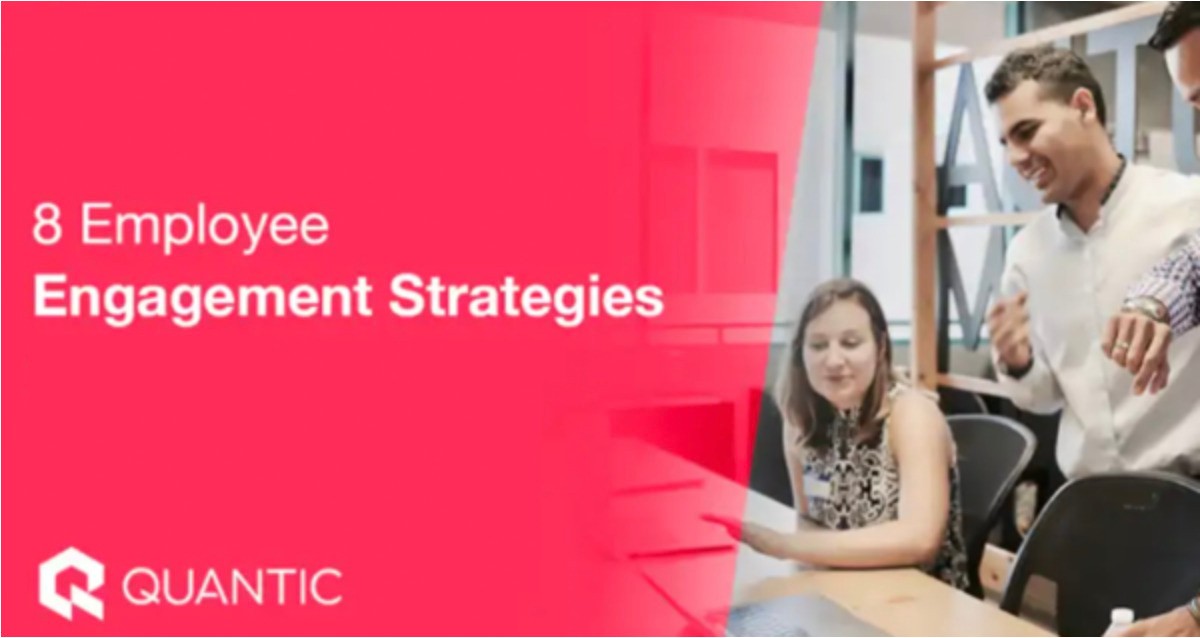CAREER PLANNING
10 Employee Engagement Strategies for 2024
Seeing your engagement strategies fail and your operational systems run amok is nothing new in times of change.
Significant shifts in the labor market only exacerbate issues.
The great arena where corporations and top talent have been matching strengths has kept us on the edge of our seats for decades. Lately, it seems talent has been on the winning streak.
The rat race for the top-skilled workers is harsher than ever, and employee turnover is as expensive as it ever was.
Thus, it doesn’t surprise that employee engagement is top of mind for most HRs and higher-ups.
But how do you stay on top of all your HR challenges and improve employee engagement?
That’s where 10 employee engagement strategies for 2024 come in. We’ve nailed down the essentials so you can avoid wasting time.
Before we dive into our strategies, let’s cover some background information…
What Is Employee Engagement?
Employee Engagement Definition: Employee engagement refers to the emotional connection an individual has with their workplace, which influences their level of effort in achieving organizational goals.
Employees who are emotionally invested in their work tend to be more productive, creative, and dedicated.
How Is Employee Engagement Different To Job Satisfaction
Employee engagement often gets mixed up with job satisfaction, but they’re not equivalent.
- Job satisfaction: This concept focuses on how happy or content an employee feels at work. Factors such as compensation, work environment, and relationships with colleagues contribute significantly towards job satisfaction levels.
- Employee engagement: On the other hand, this term goes beyond mere happiness by considering aspects like motivation, dedication towards one’s role within the company, and willingness to go above and beyond expectations. Highly engaged employees are not only satisfied but also passionate about contributing positively towards organizational success.
Satisfaction is the feeling of personal happiness and contentment with a job. Engagement has more to do with a proactive approach and the level of motivation.
It’s a commitment to the organization and the driving force behind employee performance.
Why Is Employee Engagement Important?
There are plenty of reasons to adopt targeted practices to improve employee engagement. Yet, it’s a missing link in many organizations. They go without any systematic approach.
“Just 26% of leaders surveyed say that employee engagement is a very important part of what they think about, plan, and do every day. Another 42% say they work on it frequently, and the rest only occasionally, rarely or never.” Source: Hubspot
There’s a strong business case for adopting continuous initiatives in this field — plenty of industry data points toward significant employee engagement gains.
Organizations with an engaged workforce:
- Demonstrate superior performance.
- Have a higher earning per share.
- Recover more quickly following financial setbacks.
- Are more likely to attract and retain top talent.
The Employee Engagement Model
It’s difficult to find an effective employee engagement model that works. Senior leaders are facing a host of challenges — not just having their newly trained workers poached by other firms.
Other issues include active disengagement and the demands for improved leadership.
So, how do you address those challenges?
First, you need to understand the key drivers of employee engagement in your organization.
To do this, ask yourself the following questions:
- How do employees connect and engage with the organization as a whole? Does your company culture nurture fairness, trust, and respect?
- How do employees connect and engage with direct managers? Do they receive fair treatment and good direction from them?
Saying a positive work environment and good leadership are key to engaging employees is being too vague.
You need to build a model that makes sense for your organization. Now that you understand the significance of employee engagement, let’s delve into some practical strategies…
10 Employee Engagement Strategies
1. Foster Your Company’s Core Values
Your core values should be at the heart of your company culture — and here’s the how and why of it.
Employee surveys show Millennials seek jobs and careers they find meaningful and engaging.
Just a reminder: by 2025, Millennials will represent up to 75% of the global workforce. That said, the topic of creating a purposeful work environment deserves serious thought.
Articulate your company core values and you’ll create a cohesive workforce gathered around common ideals.
Your values should serve as a backdrop for everything you do as a team. Here are a few ideas:
- Create a company mission document and put it out to new hires to keep them in the loop from day one.
- Launch an internal company newsletter.
- Make this topic a staple of your all-hands executive presentations.
To attract top talent that will be engaged from day one, HR teams should develop recruitment strategies that highlight company values and emphasize growth opportunities.
This includes crafting compelling job descriptions that showcase potential career paths and leveraging social media platforms for employer branding.
2. Create a Culture of Respect
In the grand scheme of things, people love to be respected for the input they make and ideas they propose. So, a good culture of respect includes a good level of dialogue and openness.
Organizations that are great at employee engagement are employee-centric cultures.
21st-century workers value diverse and inclusive workplaces above all else. It’s what a person brings to the organization that counts, regardless of their sex, race, age, culture, or religion.
Here’s a couple initiative ideas:
- Teach your recruiters and managers how to deal with unconscious bias.
- Comb through your executive team: are they acting on values of respect and diversity?
3. Integrate Core Values into Daily Operations
For fostering a culture that encourages staff involvement, it is essential to incorporate the company’s fundamental principles into daily operations.
Here are some ways to achieve this:
- Leadership Example: Ensure leaders embody the organization’s values through their actions, decisions, and communication styles.
- Hiring Practices: Align recruitment strategies with your company’s principles by assessing candidates’ cultural fit during interviews.
- Rewards & Recognition: Develop programs that celebrate employees who demonstrate adherence to organizational beliefs in their work performance or behavior.
- Policies & Procedures: Review internal guidelines regularly to guarantee alignment with established standards while making necessary adjustments as needed.
- Ongoing Reinforcement: Communicate about value-based successes regularly through meetings, newsletters, or other channels; provide opportunities for staff members to share stories related to living out these principles.
4. Provide Opportunities for Growth
Many organizations already offer valuable strategic compensation to encourage incentivized behaviors. However, skill development training is where you should look for long-term organizational benefits. Upskilling your employees has proven benefits like improving retention and keeping your team motivated.
Here’s some hard data to support this claim.
94% of employees would stay at the job longer if the company offered more opportunities to advance their careers.
By providing growth opportunities, you’re announcing your organizational values to the world.
Top performers want to get their hands on marketable skills. They work towards earning more senior roles — so you may as well give them what they want.
Here’s how:
- Set quarterly or monthly learning and development goals for each team member.
- Design transition management programs to encourage promotion from within.
- Give people time to learn (this is the number one barrier people state in surveys).
- Include attractive coursework as part of a compensation and benefits package.
5. Tuition reimbursement
Tuition reimbursement is a great way to retain team members at the executive level. It’s how you nurture great leaders and encourage other team members to aim for more senior positions.
Quantic’s Executive MBA Tuition Reimbursement Program is a premier graduate education option. By providing your team with an MBA degree, you create excellence in leadership.
This program is attractive to organizations because it offers:
- True career acceleration empowerment. The program is designed to educate business leaders and empower them to work towards key business outcomes.
- Affordable tuition fees. Our best-in-class MBA programs are more affordable than traditional top business school programs.
- Proven career outcomes. 94% of our alumni say they met their career goals post-graduation.
- A seamless time-saving program. Our MBA program is designed to create minimal disruption; your employees complete courses without compromising work.
- An excellent alternative to Ivy League MBAs. In a standardized test, Quantic learners performed as well or better than MBA students coming from the top 10 business schools.
If you’d like to try out our learning methology first, then you can sign up for our free open courses.
6. Be Clear About How Your Employees Fit in the Big Picture
First off, high-performing workers are those that clearly understand their role. Being just a cog in the machine is unlikely to engage anyone.
Next, if you want your staff involved in achieving organizational goals, they need to know what those goals are. Letting them know how their role plays out is paramount.
Providing a clear vision from the top down is the most effective way to increase engagement organization-wide.
Hold regular meetings to help the team stay on top and discuss how each member contributes.
7. Recognize Top-Performers
Want to produce new top performers while also encouraging existing ones? Here’s a good incentive: recognize individual achievements.
It’s understandable — people are unlikely to perform better if their good work is ignored.
However, it’s nothing some good management can’t fix.
How to Create Effective Reward and Recognition Programs
Acknowledging the hard work put forth by your employees is crucial in maintaining high levels of motivation. Implementing reward and recognition programs, such as peer-to-peer appreciation systems or monthly awards for outstanding performance, can go a long way in boosting morale within the workplace. Here are some steps you can take:
- Create a platform where colleagues can nominate each other for exceptional contributions.
- Establish clear criteria for rewards based on company goals.
- Incorporate both monetary incentives (bonuses) as well as non-monetary ones (public acknowledgment).
- Celebrate small wins along with major milestones to keep momentum going throughout the year.
8. Foster Great Management
Engaged employees feel their work helps the organization achieve long-term goals.
Good management is one of the key drivers of engagement. Everyone’s work relies on the management’s success in guiding and aligning their people.
That’s why your investment in managerial teams measures in improved retention, performance, and engagement.
With that in mind, there’s always room to improve:
- Implement empathy training for managers.
- Use employee surveys to evaluate managerial effectiveness.
- Have regular one-to-ones to help solve issues on the go and inspire managers to do their best.
9. Encourage Two-Way Communication
Skill development training, self-efficacy, and recognition aren’t the only ingredients of job satisfaction.
Allowing honest employee feedback is also high on the list. Employees who are free to voice their opinions to their higher-ups feel valued.
Being attentive to your team’s feedback improves their commitment to your organization. Below are some ideas on how to improve your communication:
- Promote feedback channels across the board and encourage team members to share thoughts and ask questions. This can include digital channels like Slack and Microsoft teams.
- Give prompt answers and act on employee feedback.
- Give shoutouts when someone’s suggestions or ideas are implemented. It’s an excellent way to let your team know about the impact they make.
- Implement regular town hall meetings.
- Encourage an open-door policy.
10. Empower Your Managers to Coach
Lastly, initiating a mentorship program is one of the best things you can do to boost performance.
A coaching culture has been known for its strong impact on an organization’s health. Yet, many managers are missing the point of seeing supervision as their key responsibility.
Their greatest contribution comes down to coaching employees.
That said, empower your managers to coach. Inaugurate coaching as one of the official goals for your managers’ performance evaluations.
One big plus of this is that the attitude of an engaged manager will rub off on the rest of the team.
Build Your Employee Engagement Plan
So, how do you build your employee engagement plan?
The key is to narrow down and decide which drivers of employee engagement you want to focus on.
Breaking them down into categories will help you identify areas of improvement. You can add or remove categories on the below chart, depending on your organizational needs.
To start carving out your employee engagement strategies select one of the categories.
Take “Goals & Alignment” for example, then work your ideas through the list of questions below:
- Do we have specific initiatives that support this driver of engagement?
- Will addressing this area solve some of our burning issues?
How can we improve in this area?
Once you’ve identified areas that need immediate attention, start building a systematic action plan around them.
| Pro Tip: The most successful employee engagement strategies are intentional and data-driven. Administering surveys will help you reach better decisions about which initiatives will truly serve your organization. Use engagement and pulse surveys to find out what makes your employees tick. Also, make sure to follow up on the results. |
Employee Engagement Goals and Objectives
Your employee engagement initiatives should work towards concrete, well-defined objectives.
Only after you’ve defined them and put them in the pipeline can you measure the success of your efforts.
High-level corporate objectives examples
- Increase employee engagement by 15% within the next year
- Reduce voluntary turnover rate by 10% in the next two years
- Achieve a minimum of an annual growth rate of 20%
Developing high-performance work teams, improving communication channels, and offering skill development opportunities are just some ways to achieve these overarching goals.
Start small, pick a few relevant objectives, and break them down into task activities. This way you’ll be able to gauge and manage results without splurging your resources.
Employee Engagement Strategy Examples in Action
Companies That Nail Employee Engagement
Care to learn about a few successful examples? Below are companies that nailed it with their employee engagement initiatives.
- CB Insights. This NYC-based market intelligence company offers a $1,000 education stipend to team members that hit the six-month mark. It hosts a quarterly female-focused professional development lunch and monthly management training.
- Subsplash. This innovative company features the “Animal of the Week” employee recognition initiative. Exceptional individual achievements are recognized at a weekly all-hands company meeting. Behavior aligned with company core values (humility, proactivity, and excellence) is especially cheered on.
Successful Employee Engagement Programs
The higher-ups want to see employee engagement initiatives that drive results. Being clear on the objectives is a good place to get started, but seeing how others are doing it weighs in too.
Below are some organizations that get results from its employee engagement initiatives.
- Caterpillar, a construction-equipment company, has seen considerable benefits from their employee engagement initiatives. They resulted in $8.8 million annual savings from decreased attrition, absenteeism, and overtime in their European plant.
They’ve also seen a 34% increase in satisfied customers in their start-up plant.
- Google and Intel are another shining examples. They’ve introduced this remarkably agile goal-setting process called OKR (objectives and key results).
The team members set their individual goals and outline their “key results.” These are, in turn, used to monitor employee progress. The framework creates clarity, alignment, and easy performance measurement.
Your Employee Engagement Action Plan
So, how do you put into place your own successful initiatives?
First, the leadership and HR settle down on one area of focus — for example, growth opportunities. Then, an action group gets on writing the action plan.
Here’s how it looks:
- Recruit a team responsible for leading the action plan.
- Determine the budget and timeline and schedule regular meetings for the action group.
- The team then develops a plan. They create a list of options for their prospective action plan.
- A report is created and presented to the leadership. It includes a timeline, expected costs, and the projection of the outcome.
- Next, the leadership adopts the plan, makes adjustments, and approves the budget.
- Finally, the team gives regular presentations to update the leadership on progress, until the project is completed
Next Steps
Implementing on-paper employee engagement strategies takes effort. Yet, there’s a compelling business case that pins down considerable employee engagement gains.
Laying out a clear path for your initiatives is the best way to ensure their success — and now you have the tools for it.
Launching a tuition reimbursement program is a great way to get started. Make an Executive MBA degree available to your employees and you’ll be putting your organization on the map.
Doing so empowers you to retain team members at the executive level and motivates managers to achieve their career goals.
Quantic School for Business and Technology offers a free online MBA that can help you attract new hires and produce future business leaders starting from today.



